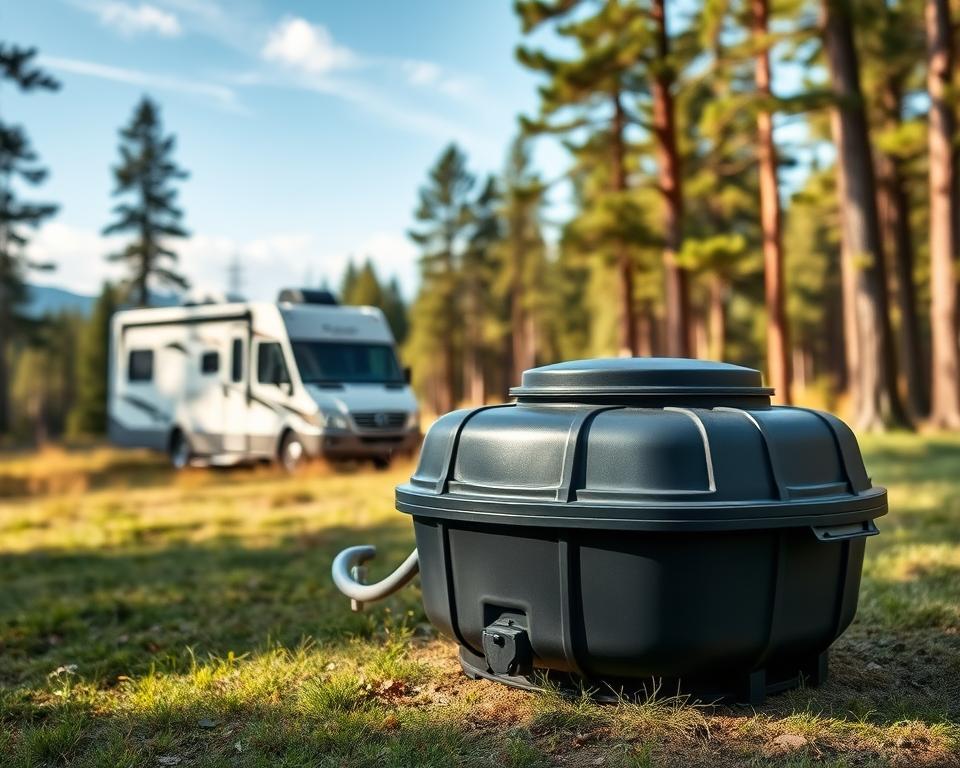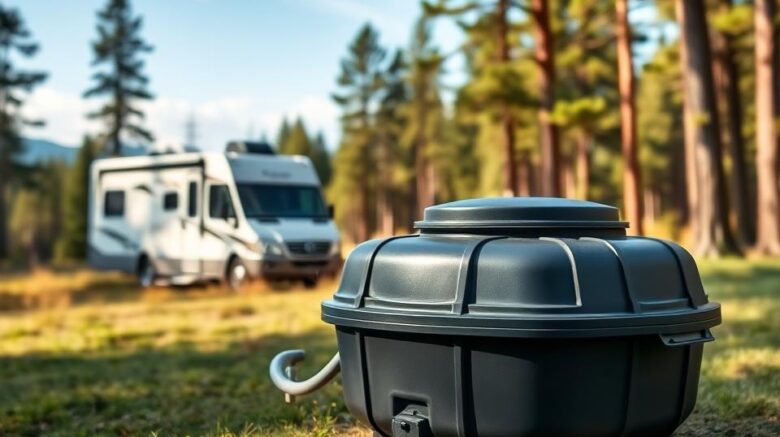RV Wastewater Pump Guide: Essential Tips for Maintenance
Did you ever ponder the functioning of your RV’s sewer system? Knowing the details of your RV sewer pump can avert mishaps, improving your camping excursions. It focuses on overseeing waste effectively and warding off foul smells. Through this guide, you’ll discover essential maintenance methods for RV tank pumping service. All are intended to preserve your waste disposal system’s ideal functionality.
Learning About Your Camper Waste Pump Configuration
The recreational vehicle waste pump network is vital for refuse disposal, making RV outings more convenient. It consists of two principal tanks: the black water tank for solid waste and the grey water tank for water from wash basins and shower stalls. Distinguishing between these tanks is key to stop clogs and keep your RV performing optimally.
An RV macerator pump is a favored option for refuse disposal. It chews up solid waste into fine pieces, streamlining disposal. Alternatively, a traditional camper sewage pump is available. It competently moves waste without grinding, for those choosing a simpler option.
Knowing your RV’s sewage pumping system is essential to preventing problems and ensuring trouble-free evaluations. Managing the system correctly can prevent messes, improving your outdoor adventures.
Why Consistent Upkeep Matters
Servicing your RV sewage disposal pump is essential for a smooth travel experience. Without proper care, you may run into odors, clogs, or backups. These problems can mar your road trips.
Scheduled upkeep prevent such issues and prolong your system’s life. By reviewing hoses and seals, you maximize efficiency. A regularly checked RV sewage pump provides effective refuse removal, letting you enjoy continuous journeys.
Consistent attention also brings financial savings over time. Disregard can cause major issues, requiring high-cost fixes. Investing in regular maintenance keeps your motorhome in top condition, saving money long term.
How Frequently to Service Your RV Septic Tank?
Understanding when to empty your RV Septic Tank is vital for its upkeep. It’s recommended to pump every 72–120 hours during use. For quick getaways, pumping on return may do the trick.
Interval depends on several factors. Tank capacity and occupancy are key. Best practice is to pump when it reaches two thirds. This helps support uninterrupted discharge and avoid backups.
Monitoring your RV tank fill level is essential for a pleasant excursion. Handle your camper’s effluent to stop issues while traveling.

Top Techniques for Tank Drainage
Safely purging RV tanks is crucial for your motorhome’s sanitation and operation. Begin with the black tank to let the grey tank liquid rinse leftover solids. This approach stops clogs and ensures seamless flow.
Pick a top-grade drain hose for disposal. A heavy-duty hose ward off leaks and locks connections. Include a tank rinser for a deep clean, using water pressure to remove remaining debris, upgrading cleanliness.
Complete purging prevents residue buildup, warding off foul odors and potential issues. To maintain an optimal sewage system in your motorhome, follow these guidelines:
- Always add a tank treatment after emptying to control odors and decompose waste.
- Keep an eye on fill levels to avoid leaks.
- Inspect your RV waste pump regularly for clogs and wear.
- Deep rinse tanks each month or twice monthly, even during infrequent outings.
Following these methods enhances your sewage system’s resilience and efficiency, ensuring pleasant trips.
Avoiding Foul Odors and Clogs
For a enjoyable trip, preventing foul aromas is vital. Maintain adequate water level to aid in waste breakdown, warding off unpleasant odors. Also, using RV-safe toilet paper helps prevent clogs, keeping the system running smoothly.
For enhanced refuse control in campers, try enzyme-based tank treatments. These process sludge thoroughly, easing upkeep. Regularly inspect the vent pipe to keep air moving freely in the plumbing system.
Mindful disposal is key to avoiding tank issues. Avoid flushing wipes, feminine products, and paper towels. These non-degradable objects can cause significant obstructions. Adhering to these guidelines helps maintain a tidier camping environment.
RV Sewer Pump Maintenance Tips
Caring for your camper’s waste pump setup is crucial for trouble-free travels. Inspect dump valve seals regularly to avoid drips. Worn seals can cause unwanted leaks, harming your RV.
To banish smells and maintain cleanliness, sanitizing is key. Perform a deep clean every few months to avoid deposits, ensuring the system performs reliably. These steps are critical for maintaining a portable RV pump, promoting long life and optimal performance.
Greasing valve components is another crucial task. It helps prevent leaks and improve functionality. Monitoring tank sensors is key for accurate readings, preventing spillovers and unexpected pump issues. Staying on top of these checks makes your RV adventures more sanitary and more enjoyable.
Clues for Hiring a Professional Pump Service
Spotting sewage issues early can save you from bigger headaches. A primary clue you need a professional pump-out is sluggish flow. When sinks and toilets take longer to clear, it often points to obstructions. It suggests your system may be backed up.
Lingering smells are another distinct indicator of sewage troubles. Unpleasant fumes hanging around despite cleaning suggest trapped waste. It’s crucial to inspect the clear elbow attachment when dumping waste. Remaining waste visibility signals it’s time for expert emptying.
Technicians employ water-jet systems to dismantle stubborn blockages efficiently. Ignoring these warnings can snowball major problems. Therefore, it’s imperative to seek help immediately when issues arise.
| Indicators of Sewer Trouble | Possible Action |
|---|---|
| Slow Draining | Look for blockages; schedule pro maintenance |
| Lingering Smells | Examine system; book professional RV pump-out |
| Visible Waste Residue | Contact pump service for thorough cleaning |
How to Pick Your Camper Macerator
When evaluating an RV macerator pump, weigh its volume handling, build quality, and compatibility with your RV’s size. A high-quality macerator is critical for smooth sludge processing. This is especially true for RVs requiring frequent disposals. High-end pumps enhance sewage handling, ensuring a smoother RV lifestyle.
Various units cater to varied requirements. For an well-founded selection, focus on these critical elements:
- Capacity: Confirm volume capability suits your needs.
- Durability: Select long-lasting equipment.
- Ease of Use: Select pumps with intuitive controls.
- Compatibility: Verify the pump fits your RV plumbing.
Carefully considering options when choosing an RV macerator pump enhances travel enjoyment and ensures proper sewage disposal.
Fixing Common RV Pump Issues
Proper troubleshooting for your RV sewer pump is essential in rectifying common sewage issues before they worsen. If you notice sluggish emptying, unplanned backflows, or persistent odors, act quickly. These are clear signs of malfunction requiring attention.
Begin by examining the pump, its connections, and hoses. Look for any clogs that could slow flow. Ensure inlet and outlet fittings are tight. Also, verify the pump’s power supply for reliable current.
If basic checks fail to reveal the issue, note the pump’s sound. A unit that’s too loud or abnormally quiet may have internal damage. Also, check for leaks, as these can magnify sewage problems. With these troubleshooting steps, many RV owners can find and fix issues early, avoiding costly repairs.
Ongoing Care for Your RV Pump
For long-term efficiency, dedicate yourself to regular sewer pump upkeep. Flush the system consistently to prevent clogs. Set up and follow a maintenance routine, keeping everyone informed of their roles. This considerably increases your waste system’s lifespan.
Training yourself and others on correct flushing habits is key. This preventss issues and fosters shared responsibility. The result benefits both users and the sewer system.
- Inspect plumbing and hoses periodically
- Cleaning filters regularly
- Scheduling professional servicing annually
- Using appropriate tank treatment chemicals
Sticking to these steps prolongs your camper’s sewage system’s durability and keeps it functional, making travels more delightful.
In Closing
Maintaining your camper’s waste pump properly is vital for hassle-free camping adventures. Regular attention to RV sewer system maintenance markedly cuts problem risks, letting you engage in the journey. By understanding your system and using reliable sewage methods, your trips will be free of waste management woes.
Implementing the key tips from this guide promotes RV waste management and enhances your travel comfort and safety. Ensure pump reliability by following best upkeep practices and fixing potential issues promptly.
Being watchful and well-informed about your RV sewer system is rewarding. It provides homely comforts while exploring. Wishing you joyous and carefree journeys!
Common Queries
How can I tell it’s time to empty my RV Septic tank?
Empty your RV Septic tank once it’s two-thirds full.
Black tank vs. grey tank: what’s the difference?
Black tank is for sewage waste. On the other hand, the grey tank collects water from sinks and showers.
When to service my RV sewer pump?
Inspect and sanitize system about every three months.
Which products are best for RV sewer pump care?
Opt for biological tank additives.
How do I avoid clogs in my RV sewer system?
Avoid flushing non-biodegradable items.
When should I call a pro for RV pump service?
Blockages, foul scents, or tank overflow warrant expert service.
Making your RV macerator pump work better?
Select a correctly sized pump for your RV.
What should I check during a deep clean of my RV sewer system?
Clean sensors and lubricate valves.
What long-term care tips help my RV sewer pump?
Adopt regular deep cleans and consistent sanitation.
How often should I empty my RV Septic tank with regular use?
Schedule pump-outs every 3–5 days.
